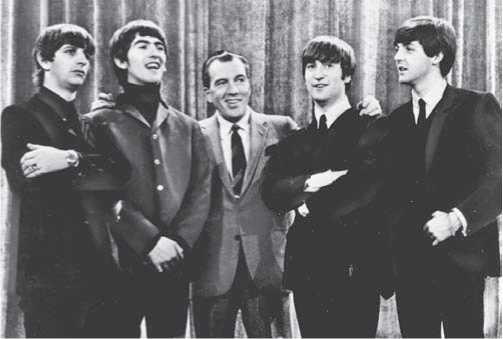A British rock and roll band, the Beatles brought their music and their enigmatic personalities to America in the 1960s and became a voice for counterculture youth.
The Beatles were formed in 1957 by John Lennon, Paul McCartney, and George Harrison in Liverpool, England. In 1962, the group replaced then drummer Pete Best with Ringo Starr (Richard Starkey), uniting the quartet that revolutionized popular music in the 1960s. The band went through several name changes, including the “Quarrymen,” “Johnny and the Moondogs,” and the “Silver Beetles,” before settling on “Beatles,” a name (and spelling) that came to Lennon in a dream. Influenced by American rock and roll musicians of the late 1950s, the Beatles’ early repertoire included Carl Perkins, Chuck Berry, and Buddy Holly songs.
The group gained popularity in England by playing clubs such as the Cavern, a local Liverpool nightspot, as they sang their own songs composed primarily by Lennon and McCartney. The upbeat melodies, harmony vocals, and simple lyrics that characterized early Beatles’s songs such as “Love Me Do,” “P. S. I Love You,” and “Please Please Me,” combined with the high-spirited personalities and boyish good looks of the band members, propelled the Beatles to stardom in England. By 1963, crowds of hysterical fans thronged Beatles’ performances attempting to catch a glimpse of the foursome and “Beatlemania” was born. That same year, their single, “From Me to You,” went to number one on the British charts, followed by “She Loves You,” which became the biggest-selling single in British history.
Yet in the United States, the “Fab Four” continued to remain relatively unknown. It was not until February 7, 1964, that the Beatles stepped off a plane at New York’s Kennedy Airport and stepped into American popular culture history. Their February 9, 1964, appearance on “The Ed Sullivan Show” marked the first time most Americans got a glimpse of the band, and proved to be a watershed moment in television history. Seventy-three million people tuned in to watch the Beatles perform five songs, shattering the previous record for the largest American television viewing audience. Their mop-topped heads, clean-cut appearance, and cheeky sense of humor won over American audiences, catapulting the Beatles into mainstream culture in a short time.
An aggressive merchandising campaign brought Beatles wigs, clothes, and dolls to the market, and fans flocked to stores to buy the latest Beatles magazine or album. In April 1964, the band held the top five positions on Billboard magazine’s singles chart with “Can’t Buy Me Love,” “Twist and Shout,” “She Loves You,” “I Want to Hold Your Hand,” and “Please Please Me.” The Beatles quickly became four of the most recognizable men in America. When John Lennon commented in 1966 that the Beatles were “more popular than Jesus Christ,” the tarnish from their popularity faded momentarily, but their resilient nature outlasted the bonfires some outraged fans lighted to destroy their Beatles albums.

Ed Sullivan and the Beatles (Library of Congress)
While delighted with their early recording efforts, the Beatles experimented with innovative sounds and more complex lyrical arrangements in later works. Their album Sgt. Pepper’s Lonely Hearts Club Band (1967), considered by many to be the first concept album, incorporated elements of electronically altered sounds, exotic instruments, and enigmatic musical verse. Songs such as “Lucy in the Sky with Diamonds” and “A Day in the Life” were carefully examined by listeners for hidden messages and meanings. The Beatles extended their creative talents to movies, a form they had explored previously with the release of A Hard Day’s Night (1964) and Help! (1965), producing Magical Mystery Tour (1967), a film panned by critics but representative of their creative talents and manifold countercultural influences. A brief encounter with transcendental meditation and the Maharishi Mahesh Yogi influenced their musical style, as Indian rhythms and instruments combined with experimental electronic sounds to create innovative music. Albums produced in this period, The Beatles (referred to as the White Album) (1968), Abbey Road (1969), and Let It Be (1970) reflected the band’s ability to expand the scope of its musical style, and influenced a generation of musicians who tried to copy its sound and techniques.
The Beatles broke up in 1970 and each member pursued a career in music, either as a solo act or with other bands. While all found success in their endeavors, rumors of a Beatles reunion persisted until the shooting death of John Lennon on December 8, 1980, outside his New York City apartment building. The Beatles were inducted into the Rock and Roll Hall of Fame in 1988.
In subsequent years, the three surviving band members continued to release music as solo artists and to augment their rock-and-roll legacy. After battling cancer throughout the 1990s, George Harrison died on November 29, 2001, at the age of 58. In 2004 Harrison was inducted into the Rock and Roll Hall of Fame as a solo artist, an honor bestowed on Lennon in 1994 and McCartney in 1999.
Further reading: Walter Everett, The Beatles as Musicians: Revolver through the Anthology (New York: Oxford University Press, 1999); Michael Bryan Kelly, The Beatle Myth: The British Invasion of American Popular Music, 1956-1969 (Jefferson, N. C.: McFarland, 1991).
—Susan V Spellman




 World History
World History


![Road to Huertgen Forest In Hell [Illustrated Edition]](https://www.worldhistory.biz/uploads/posts/2015-05/1432477693_1428700369_00344902_medium.jpeg)






